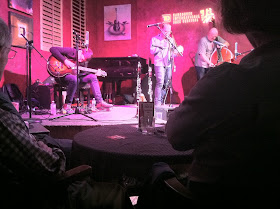 |
| Aram Bajakian, Francois Houle, Samuel Blaser, Torsten Mueller |
A five o’clock set at
Ironworks on Tuesday opened with the duo of Swiss trombonist Samuel Blaser and Vancouverite François Houle on clarinet, playing
music that skirted the boundaries between jazz-inflected improvisation and
open-scored new music. This reed-and-slide (Houle's term) instrumental combination has
precedents in Albert
Mangelsdorff and Lee Konitz’s Art of
the Duo (1988), which built on Konitz’s 1967 Duets, and also – even earlier, and perhaps stylistically a little
closer – in Jimmy Guiffre
and Bob Brookmeyer’s contrapuntal interplay in trio with Jim Hall in the
late 1950s. Samuel Blaser’s fleet, warm tone is closer to Brookmeyer, although
he occasionally shares some of Mangelsdorff’s vocalic depth and probing
polytonality. Houle, too, has acknowledged some indebtedness to Guiffre’s
later, freer musical concepts, although he points to Bill Smith and to John
Carter as more compelling antecedents. (Carter’s duos with cornettist Bobby
Bradford might also set some textural precedents for Blaser and Houle’s
reed-and-slide, as might Gerry Mulligan’s front lines with Brookmeyer and with
Chet Baker.) Houle’s playing sometimes recalls Debussy and Messiaen, too, while
Blaser – occasionally echoing a little Baroque sackbut – has reframed late
Renaissance compositions by Monteverdi, Machaut and DuFay; he and Houle offer a
multimodal, polymorphic and richly evocative music.
The two-horn line can seem
spare and linear, but both Blaser and Houle have a fullness of tone and a
sensitivity to space, as well as a willingness to let melody and line resonate
and open out into the room. The music builds on close, intimate, mutual
listening, mixing counterpoint with thickly vertical harmonizing; playing two
clarinets at once, Houle instantaneously concocts Pythagorean-sounding harmonies
that make me think of Rahsaan
Roland Kirk’s Natural Black
Inventions: Root Strata and Kirk’s performances with trombonists Dick
Griffin and Steve Turre. I don’t mean, by mentioning all of these other
players, to suggest that this music is derivative: Blaser and Houle produce
music of striking originality and boldness. But I also hear a deep sense of
history and of performative inheritance that locates their work alongside that
of some of the greatest and most challenging improvisers of this past century.
 |
| Francois Houle, Samuel Blaser (The camera seems to have auto-focused on the back of pianist Benoit Delbecq's head -- who was sitting in front of me.) |
 |
| Aram Bajakian, Samuel Blaser, Torsten Mueller |
In contrast, guitarist Aram Bajakian and bassist Torsten Müller
followed with a freely improvised duet that focused on mesmeric drones. They
began with Derek Bailey-like sparse plucking, but soon morphed into sustained
overlapping tones, Müller favouring arco to create a singing, low continuo.
Aram Bajakian, sitting to the side of the stage on a piano bench, used a few
delay pedals to draw looping hums from his strings. I have to say that for a
few moments, or minutes, I lost a clear sense of bounded time as I listened;
their interactions were hypnotic and intense, even though both had a fairly
modest stage-presence, and were more interested in co-creative agency than in self-assertion. (Interestingly, at a few points in the session
police sirens bled through the walls from the streets outside; the musicians,
rather than frustrated, appeared willing to respond in kind, drawing the outer
world’s aural palette into their own emergent soundscapes.) Blaser joined Bajakian
and Müller to make a trio, and again the group primarily concentrated on
collective sounding, long, layered lines from which brief shards of melody
sometimes emerged, only to submerge again is the collaborative flow. At one point, Bajakian
pressed a small motorized wheel into his strings over the pickup to overcome
the guitar’s natural decay, developing rich resonances and electrified overtones
from the instrument reminiscent of folk violin: concordant depth. Houle returned for a final quartet, a shape-shifting
shared composite of the contrapuntal and the harmonic; again, the attention to
space seemed paramount, so much so that for the final minutes Müller had stopped playing, bow at his side, intently listening and letting the piece take its course
toward mutual silence, as an inspiring set of exemplary, sterling and powerful
improvisation drew to a hushed close.
 |
| Aram Bajakian (Torsten Mueller in the corner) |
No comments:
Post a Comment